|
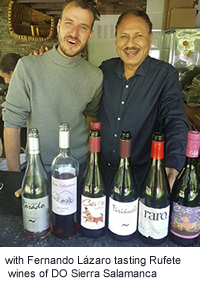 Castilla y Leon-the largest administered region of Spain, has famous wine regions including DO Ribera del Duero, DO Toro, DO Cigales, and DO Rueda for white wines (and DO Bierzo for the last couple of decades). Castilla y León authorities (Junta de Castilla y León) had put together a unique programme designed to reveal the hidden treasures of this major wine region.It was truly a one-off opportunity to broaden one’s knowledge of Bierzo and discover the emerging and fascinating appellations of Arribes, Arlanza, Sierra de Salamanca and Tierra de Léon. ‘The trip is an outstanding opportunity to uncover the region, its history, culture and gourmet food offerings by immersing oneself in the new wave wine culture of Castilla y Léon,’said the invite and I snapped up the opportunity to visit the 5 DO (Denominacion de Origen) regions, equivalent of DOC wines in Italy. Castilla y Leon-the largest administered region of Spain, has famous wine regions including DO Ribera del Duero, DO Toro, DO Cigales, and DO Rueda for white wines (and DO Bierzo for the last couple of decades). Castilla y León authorities (Junta de Castilla y León) had put together a unique programme designed to reveal the hidden treasures of this major wine region.It was truly a one-off opportunity to broaden one’s knowledge of Bierzo and discover the emerging and fascinating appellations of Arribes, Arlanza, Sierra de Salamanca and Tierra de Léon. ‘The trip is an outstanding opportunity to uncover the region, its history, culture and gourmet food offerings by immersing oneself in the new wave wine culture of Castilla y Léon,’said the invite and I snapped up the opportunity to visit the 5 DO (Denominacion de Origen) regions, equivalent of DOC wines in Italy.
DO Sierra Salamanca
Driving past the town of Salamanca we took small highway reaching a quaint hotel Sierra Quil’ama in the village called San Miguel de Valero, which marks the boundary of this denomination, for a pit stop where we were met by Fernando Lázaro, Assistant Manager at the local agricultural institute. 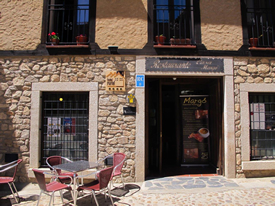
Fernando accompanied us to the terraced vineyards of Sierra de San Esteban vineyard, hallmark of DO Sierra Salamanca, the smallest appellation in Spain with only a total of 100 hA under its belt. The hilly terrain has a grape growing history of 2000 years. It is believed that grape growers from Burgundy came and settled down long time ago. Rufete, the indigenous grape that makes for the most of the production, appears to have some connection with Burgundy or Beaujolais ; there is even some similarity between this prominent grape of the DO in terms of flavours.
It was a very popular grape growing areas in the 1950s and 1960s when ‘millions of kgs of grapes were harvested’. Last year saw only around 300,000 kgs of grapes crushed. Reason for the drop to almost no grapes is due to the migration of farmers and farm workers to cities. Only since the 1990s there has been renewed interest in the mountain farming. Five wineries including the first co-operative started in 1959, formed an Association in 2007 and the area consisting of 26 villages was given the DOP designation in 2010.
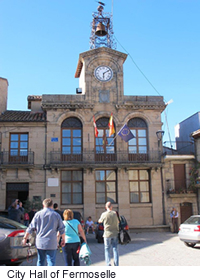 The area has humid Mediterranean climate with short winters and long summers when the nights are cool and the day-night temperature difference is high a, helping the ripening of grapes while maintaining good acidity and aromas. There are also interesting differences in flavours because of the soil difference; Vines are located at an altitude of 400m to 1000m. Vines are very old-as old as 80 years although 20 year old vines are also there and are considered young. The area has humid Mediterranean climate with short winters and long summers when the nights are cool and the day-night temperature difference is high a, helping the ripening of grapes while maintaining good acidity and aromas. There are also interesting differences in flavours because of the soil difference; Vines are located at an altitude of 400m to 1000m. Vines are very old-as old as 80 years although 20 year old vines are also there and are considered young.
There was a Rufete Wine Tasting at a local restaurant Il Restaurante El Pipero in a village called Santibáñez de la Sierra where we tasted 6 Rufete wines followed by lunch at a 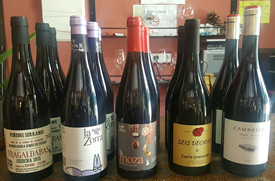 local restaurant Restaurante Casa Margo in the village of Sequeros facing Sierra de Francia Mountains, with 5 wines giving a good insight into the local cuisine as well as their speciality with the area’s cuisine. Though it would be difficult to find prospective buyers in India due to logistics issues, it’s an interesting variety that would be loved by Indians because of the flavours, balance and soft tannins. local restaurant Restaurante Casa Margo in the village of Sequeros facing Sierra de Francia Mountains, with 5 wines giving a good insight into the local cuisine as well as their speciality with the area’s cuisine. Though it would be difficult to find prospective buyers in India due to logistics issues, it’s an interesting variety that would be loved by Indians because of the flavours, balance and soft tannins.
We also visited another Rufete old vineyard owned by a -3rd generation viticulturist cum farmer running family business. The small half-hA plot had 2000 plants of only Rufete with a few vines also of the rather rare Rufete Blanco. He has taken cuttings and planted ½ hA of Blanco in another parcel as well. Rules do not allow the use of Rufete Blanco in this DO -the farmers have been trying for 7 years to have them included The government process seems to be very slow in Spain as well!
DO Arribes
After lunch we headed for the 90 minute journey towards the 110 km away town of Fermoselle in Zamora province, the seat of DO Arribes which includes wineries from both Salamanca in the South and Zamora in the Northwest.
Although ‘Arribes del Duero’ has been known to be producing wines since ancient times, records show the existence at least since 16th century. In the 17th century it was producing more than 1 million liters of wine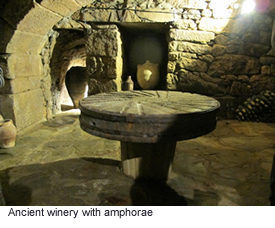 and having 421 cellars. Interestingly, phylloxera arrived here from Portugal but later than France; in fact this was the last Post in Spain to be so hit. So there was a lot of demand of grapes and wine from France in the 19th and 20th century. Since most of Europe had been already working on the solution, the crops were hit for a much lesser period. and having 421 cellars. Interestingly, phylloxera arrived here from Portugal but later than France; in fact this was the last Post in Spain to be so hit. So there was a lot of demand of grapes and wine from France in the 19th and 20th century. Since most of Europe had been already working on the solution, the crops were hit for a much lesser period.
There are extensive re-plantings with red varieties. Last year 1 million kg of red and only 70,000 kgs of white grapes were crushed. Red grapes used are the indigenous grape variety Juan García, Tempranillo, Bruñal and Rufete, with Garnacha and Mencia allowed as complementary varieties. Malvasía is the main white grape variety, being complemented by Verdejo and Albillo (nothing to do with Albariño).
The area was designated Quality Wines with a Geographical Description (VCPRD) in 2003 and elevated to DO (Denominación de Origen) Status in 2007.
The climate of the area has marked Mediterranean influences which bring in the concentrate flavours. Vineyards are at varying altitudes of 130 m and 700 m. The whole DO falls within Arribes del Duero Natural Reserve and has excellent climate for grape cultivation. Located around the Duero River Arribes is considered the original viticultural area of Duero River.
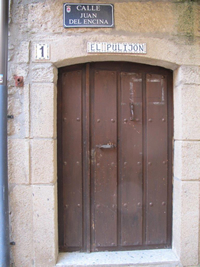 The total area of vineyards in Arribes del Duero” is about 4,800 hA and covers 47 villages-distributed almost equally between the provinces of Zamora (27) and Salamanca (20). Only 270 hA are registered as DO Arribes. The vineyards are very old; over 50% of the vines are more than 60 years old-all bush vines but like everywhere else in this region the new plantations are switching over to the trellis system. There are 17 wineries registered with the Regulatory Council, 2 of which are cooperatives. The total area of vineyards in Arribes del Duero” is about 4,800 hA and covers 47 villages-distributed almost equally between the provinces of Zamora (27) and Salamanca (20). Only 270 hA are registered as DO Arribes. The vineyards are very old; over 50% of the vines are more than 60 years old-all bush vines but like everywhere else in this region the new plantations are switching over to the trellis system. There are 17 wineries registered with the Regulatory Council, 2 of which are cooperatives.
At a grand tasting at the Posada Doña Urraca Hotel where we spent the night, there were 6 producers and wines from around 10 producers. Juan Garcia was the king of grapes here-in the varietal form or in the blend format. Really enjoyable wines, even the low cost varietals. Piece de resistance were Bruñal wines which are so limited in quantity- under 20,000 bottles are produced with some producing merely 2000 bottles-making it a unique tasting experience. These wines are like Brunello-need 5+ years of laying down though there is no structured law to define the ageing period. The tasting was followed by a dinner in the same room with the producers. Food was local cuisine and delicious with wines matching the dishes rather well.
Fermoselle has been a historic town for wine making. There have been several wineries from the 16th century, many of them criss-crossing under the town streets. We visited one of 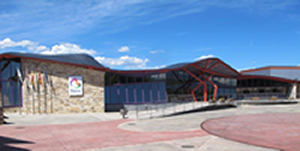 them-El Pulijon has been an active winery from that period, now used to make Sangria and used for wine tourism. them-El Pulijon has been an active winery from that period, now used to make Sangria and used for wine tourism.
DO Bierzo
As we drove from Fermoselle to Cacabelos, past the town of Zamora to reach the office of the Consejo Regulador de la denominacion de Origen Bierzo (DO Bierzo) in two and a half hours, we were greeted warmly by the staff of DO Bierzo the office of which is in a very chic, modernistic building in the village of Cacabelos.
DO Bierzo has been the Rising Star of Castilla y Leon and has already been internationally well known for a couple of decades because of its excellent local Spanish grape varieties- Godello white and Mencia red. The area is akin to its Burgundian counterpart- a single variety generally marks the characteristic of both red and white wines.
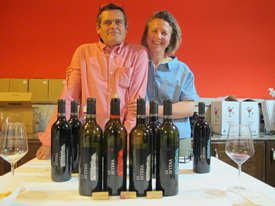 Bierzo is located in the northwest of the province of León, in the Castilla y León region. Although history of Bierzo wines can be traced back to over 2000 years ago when the vines were brought by Romans from Caucasus and Armenia, the Designation of Origin was recognized and the Regulations of The Bierzo Designation of Origin and its Regulator Board were approved in 1989. Bierzo is located in the northwest of the province of León, in the Castilla y León region. Although history of Bierzo wines can be traced back to over 2000 years ago when the vines were brought by Romans from Caucasus and Armenia, the Designation of Origin was recognized and the Regulations of The Bierzo Designation of Origin and its Regulator Board were approved in 1989.
Bierzo vineyards are characterized by fragmentation of parcels and smallholder plots, vines on slopes, from 450 to 800 meters whose are oriented to the four cardinal points. It has continental climate with the temperatures varying from a low of around 4°C to the high of 24°C.
The Board controls the origins of production by accounting for the21 municipalities in which DO Bierzo wines are produced in 21 municipalities including Cacabelos where the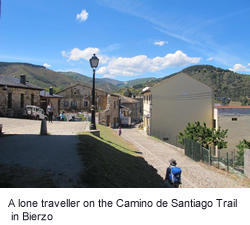 office of the DO is headquartered. office of the DO is headquartered.
Wines of Bierzo
Although it makes excellent white wines using Godello and Palomino (Sherry grapes) and Malvasia, DO Bierzo is primarily a red wine appellations. Mencia is the primarygrape variety- the red grape is grown in 74-75%. Red wines are classified as under:
JOVENES: Wines which are not aged in oak at all and are meant to be drunk young.
ROBLE: Wines which have undergone a nominal ageing in oak barrels to give some complexity.
CRIANZA: These wines must be at least 2 years old after the harvest 6 months of which must have been aged in wood.
RESERVA-Wines with at least 3 years of ageing out of which 12 months must have been in wood.
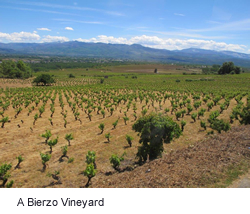 GRAN RESERVA-Wines that are aged for at least 5 years, out of which a minimum of 18 months must be in oak barrels. GRAN RESERVA-Wines that are aged for at least 5 years, out of which a minimum of 18 months must be in oak barrels.
Wine Tasting
There was a guided tasting by Sonja Soto Gonzalez of the technical department. A total of 28 wines were tasted. Although it was not the best way of tasting –bottles had been arranged in the alphabetical order of producers, resulting in a cocktail of red and white, oaked and unoaked, it was a pleasant shock for the palate. Most wines (excepting a couple of them) were very good to outstanding quality and deserve a place in the Indian market for connoisseurs of Spanish wines.
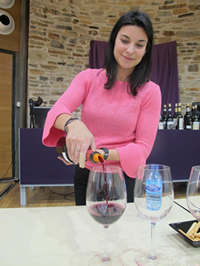 My favourite white wines were Adria Godello 2015, a bright Golden wine with tropical aromas, concentrated fruit and unoaked and very fresh with 12.5% alcohol and Bodegas y Veñedos Gancedo Capricho Val de Paxariñas 2016-a blend of 85% Godello and Doña Blanca 15%. Pale golden, complex nose, white fruits, citrus, and floral. Nice balance , fresh vibrant , juicy long end, medium body. My favourite white wines were Adria Godello 2015, a bright Golden wine with tropical aromas, concentrated fruit and unoaked and very fresh with 12.5% alcohol and Bodegas y Veñedos Gancedo Capricho Val de Paxariñas 2016-a blend of 85% Godello and Doña Blanca 15%. Pale golden, complex nose, white fruits, citrus, and floral. Nice balance , fresh vibrant , juicy long end, medium body.
Among the reds, Luna Beberide Paixar Mencia 2013 was a very pleasant wine with spicy aromas, very aromatic wine that, even though Mencia may not exactly light the fire of an Indian palate at the first encounter. Mineral, spicy and powerful wine with 14% alcohol. But decidedly the queen of all wines tasted was Casar de Burbia 2014 Nebcia El Castañal which had elegant bouquet, silky tannins, great balance and harmony and was very clean. 22 months in oak gave sweet vanilla falvours of from oak, lovely with blackberrie and other berry flavours. Although slightly high in alcohol it was well intergrated and balanced wine. As they saym it was pure magic. Unfortunately ther were only 500 bottles made, making it quite unavailable for connoisseurs.
Devastating Spring Frost
The unexpected spring frost on 29th and 30th April had caused havoc in Bierzo like several places in Eyrope, especially Bordeaux and a few other areas of Spain. As Sonia explained, 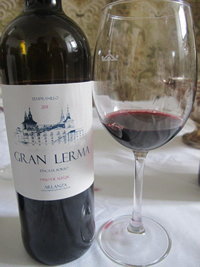 about 70% of the crops of 500 hA had been damaged with little chance of flowering again. The damage was almost 100% in the plains whereas those on the slopes had survived. Though there does not seem to be any cause for concern for the next year’s crops and some of the damaged vine might give some fruit, the incidence doe bring about 70% of the crops of 500 hA had been damaged with little chance of flowering again. The damage was almost 100% in the plains whereas those on the slopes had survived. Though there does not seem to be any cause for concern for the next year’s crops and some of the damaged vine might give some fruit, the incidence doe bring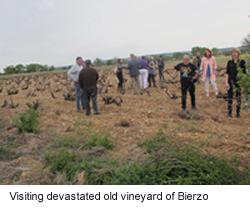 to attention the fact that in the final analysis mother nature controls the destiny of vine growers. Also, the vineyards on slopes would have higher ratings in terms of valuation, considering this risk factor, to attention the fact that in the final analysis mother nature controls the destiny of vine growers. Also, the vineyards on slopes would have higher ratings in terms of valuation, considering this risk factor,
Bierzo is a part of the religious route Camino de Santiago and this has helped the rural wine tourism. We visited a beautiful vineyard with pre-phylloxera vines, some of them 100 years old and an old church with impressions from artistic periods like Romanesque, Gothic, Baroque.
DO Tierra de Leon
After having a sumptuous Octopus Lunch (I substituted the delicacy with a vegetarian dish) at the Consortium office, stopping over to walk through a vineyard close to the office, that had been devastated completely due to the spring frost, we headed towards the beautiful city of Leon.
A seminar and tasting had been arranged by the at Hotel Parador de San Marcos Leon where we were later staying for the night after dinner. Paradores are luxury hotels owned by the government and are usually in historical buildings like museums, forts, monastery and a part of the income goes to the upkeep of these historical properties. No wonder, we almost overshot the hotel entrance while lugging our bags (cars don’t reach the entrance), thinking it was a museum or an old palace!
Leon is also a part of Camino de Santiago. it is a relatively new DO that came into existence in 2007. Known as Prieto Picudo country (the typical red grape of the area) although a relatively obscure white thus far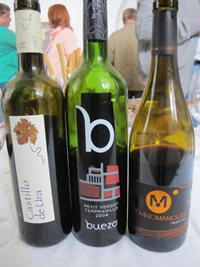 forgotten grape Albarín of unknown origin is getting popular with 19 wineries making wine, said Pablo Jose President of the Consejo Regulador de la denominacion de Origen Tierra de Leon. 1300 ha of red grapes are cultivated yearly as compared to only 60hA of Albarín. One can guess the newness of the DO when one is told that only around 2 years ago Albarín was started to be used for white wine production. It benefits a lot from the enormous day-night temperature difference. forgotten grape Albarín of unknown origin is getting popular with 19 wineries making wine, said Pablo Jose President of the Consejo Regulador de la denominacion de Origen Tierra de Leon. 1300 ha of red grapes are cultivated yearly as compared to only 60hA of Albarín. One can guess the newness of the DO when one is told that only around 2 years ago Albarín was started to be used for white wine production. It benefits a lot from the enormous day-night temperature difference.
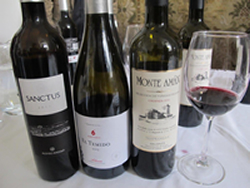 The short seminar was followed by a tasting of 5 wines including a delicious Rose. The dinner had been arranged at old winery, outside the town- a cellar-museum in Valdevimbre where typical but delicious food was awaiting with wines from several producers to taste. Despite the Mayor of the city being present, it was a very informal evening with a lot of bonhomie. The short seminar was followed by a tasting of 5 wines including a delicious Rose. The dinner had been arranged at old winery, outside the town- a cellar-museum in Valdevimbre where typical but delicious food was awaiting with wines from several producers to taste. Despite the Mayor of the city being present, it was a very informal evening with a lot of bonhomie.
DO Arlanza
We left the beautiful hotel Parador San Marcos in the morning to head towards the city of Lerma about 100 minutes away, the seat of Consejo Regulador for DO Arlanza. We arrived at yet another Parador deTurismo- 17th century Palace of the Duke of Lerma where we had coffee, followed by wine tasting from DO Arlanza and after a tour of the small town and the palace, had lunch with local wines and cuisine. During the visit we also visited an underground cellar within what is now a residential area. Also visited an old vineyard with around 100 year old vines-what seemed to be a hallmark for most areas we visited during the 3 days.
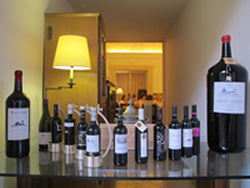 It was also accorded the DO status in 2007 and has 17 wineries as members, producing almost half a million bottles that are consumed mostly within the country. China is the biggest importer followed by the UK and the rest of EU. It was also accorded the DO status in 2007 and has 17 wineries as members, producing almost half a million bottles that are consumed mostly within the country. China is the biggest importer followed by the UK and the rest of EU.
Tempranillo known as Tinta del Pais is the principal grape variety with 95% of the crop being of this grape. Garnacha is also grown followed by a spattering of Mencia, Cabernet Sauvignon, Merlot, Petit Verdot. Almost one percentage of the crop is Albillo and Viura (Macabeo) used in white and Rose wines. Otherwise, there is a lot of similarity between Do Bierzo and here, so far as wine style is concerned. Wines are generally well made as we discovered at Lunch.
We left Lerma after lunch to get back to Valladolid in the evening at around 7 pm- in time to attend the tasting and dinner for the judges of Concours Mondial de Bruxelles which had taken the initiative to invite a few journalists for this unique visit. As the invite had pointed out, one would not normally venture into this journey and a unique experience.
For an Earlier related Article, click
CMB 2017: Rare Grapes of Castilla y Leon
Subhash Arora
|